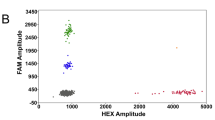Abstract
A considerable fraction of the faecal microbiota is spore-forming. Molecular quantification of bacteria may be underestimated if preceded with nucleic acid extraction without special treatment to extract recalcitrant bacterial spores. The objective of this study was to improve the DNA extraction regarding the presence of Clostridium difficile spores in faecal swine specimens. Sow faeces were inoculated with spores of C. difficile (106 CFU), frozen at − 30 °C overnight and subjected to DNA extraction. As a preceding step to a standard DNA extraction method (QIAamp DNA stool Mini kit), different physical treatments such as microwave oven heating and repeated bead-beating techniques and a combination of both were applied and compared with each other by means of qPCR. Using a standard DNA extraction method only, C. difficile spores were quantified at 4.96 log copy number/200 mg of faeces. A repeated bead-beating at 6 m/s for 10 min followed by a standard DNA extraction resulted in 5.77 log copy number of spores in inoculated faeces. Heating in a microwave oven at 800 W for 1, 3, 5 and 10 min followed by a standard DNA extraction resulted in a gene quantification of up to 4.89 log copy number. A combination of both methods resulted in the bacterial gene quantity of 5.37 log copy number. Pre-treatment with repeated bead-beating led to the highest quantification of bacteria, and therefore it can be applied for more efficient DNA extraction from spores of C. difficile in faecal specimens.

Similar content being viewed by others
References
Ahmed OB, Asghar AH, Elhassan MM (2014) Comparison of three DNA extraction methods for polymerase chain reaction (PCR) analysis of bacterial genomic DNA. African J Microbiol Res 8:598–602. doi:10.5897/AJMR2013.6459
Balestrazzi A, Bonadei M, Calvio C et al (2009) DNA extraction from soil: comparison of different methods using spore-forming bacteria and theswrAA gene as indicators. Ann Microbiol 59:827–832. doi:10.1007/BF03179230
Claassen S, du Toit E, Kaba M et al (2013) A comparison of the efficiency of five different commercial DNA extraction kits for extraction of DNA from faecal samples. J Microbiol Methods 94:103–110. doi:10.1016/j.mimet.2013.05.008
Frostegård Å, Courtois S, Ramisse V et al (1999) Quantification of bias related to the extraction of DNA directly from soils. Appl Environ Microbiol 65:5409–5420
Grześkowiak Ł, Grönlund M-M, Beckmann C et al (2012) The impact of perinatal probiotic intervention on gut microbiota: double-blind placebo-controlled trials in Finland and Germany. Anaerobe 18:7–13. doi:10.1016/j.anaerobe.2011.09.006
Grześkowiak Ł, Sales Teixeira TF, Bigonha SM et al (2015) Gut Bifidobacterium microbiota in one-month-old Brazilian newborns. Anaerobe 35:54–58. doi:10.1016/j.anaerobe.2015.07.004
Kesberg AI, Schleheck D (2013) Improved protocol for recovery of bacterial DNA from water filters: sonication and backflushing of commercial syringe filters. J Microbiol Methods 93:55–57. doi:10.1016/j.mimet.2013.02.001
Kuske CR, Banton KL, Adorada DL et al (1998) Small-scale DNA sample preparation method for field PCR detection of microbial cells and spores in soil. Appl Env Microbiol 64:2463–2472
McOrist AL, Jackson M, Bird AR (2002) A comparison of five methods for extraction of bacterial DNA from human faecal samples. J Microbiol Methods 50:131–139. doi:10.1016/S0167-7012(02)00018-0
Nakanishi K, Kogure A, Fujii T et al (2012) Development of method for evaluating cell hardness and correlation between bacterial spore hardness and durability. J Nanobiotechnology 10:22. doi:10.1186/1477-3155-10-22
Nylund L, Heilig HGHJ, Salminen S et al (2010) Semi-automated extraction of microbial DNA from feces for qPCR and phylogenetic microarray analysis. J Microbiol Methods 83:231–235. doi:10.1016/j.mimet.2010.09.003
Orsburn B, Melville SB, Popham DL (2008) Factors contributing to heat resistance of Clostridium perfringens endospores. Appl Environ Microbiol 74:3328–3335. doi:10.1128/AEM.02629-07
Orsini M, Romano-Spica V (2001) A microwave-based method for nucleic acid isolation from environmental samples. Lett Appl Microbiol 33:17–20. doi:10.1046/j.1472-765X.2001.00938.x
Permpoonpattana P, Tolls EH, Nadem R et al (2011) Surface layers of Clostridium difficile endospores. J Bacteriol 193:6461–6470. doi:10.1128/JB.05182-11
Setlow P (2014) Spore resistance properties. Microbiol Spectr 2:1–16. doi:10.1128/microbiolspec
Acknowledgments
This study is part of the SporeBiotic research project financially supported by the Animal Health and Welfare ERA-Net (ANIHWA). We thank Jonathan Riedmüller for his excellent technical assistance.
Author information
Authors and Affiliations
Corresponding author
Ethics declarations
Conflict of Interest
The authors declare no conflict of interest to the present study.
Rights and permissions
About this article
Cite this article
Grześkowiak, Ł., Zentek, J. & Vahjen, W. Physical Pre-Treatment Improves Efficient DNA Extraction and qPCR Sensitivity from Clostridium Difficile Spores in Faecal Swine Specimens. Curr Microbiol 73, 727–731 (2016). https://doi.org/10.1007/s00284-016-1123-8
Received:
Accepted:
Published:
Issue Date:
DOI: https://doi.org/10.1007/s00284-016-1123-8




